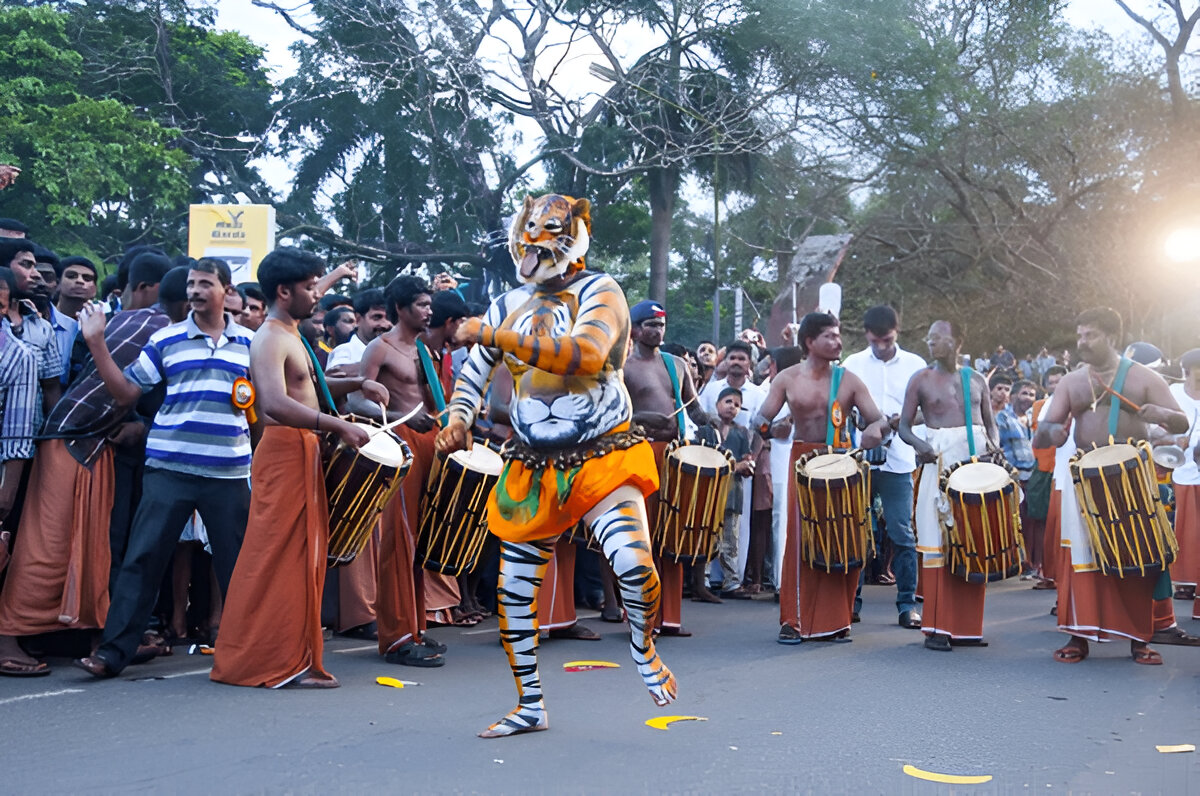the vibrant spectacle of pulikali: kerala’s tiger dance tradition
- CruiseKerala comes alive with colour, music and culture every Onam. However, one of the folk arts that really captures the imagination is the Tiger Dance, known as Pulikali. This high-energy performance integrates complex body painting, rhythmic percussion and dramatic movement to bring tigers, leopards and hunters to life.
What Is Pulikali?
The literal meaning of Pulikali is the "Tiger Dance". It is a folk entertainment art indigenous to Kerala and particularly the city of Thrissur. Dancers are painted head to toe in bright yellows, reds and blacks to mimic tigers and leopards. They dance in wild and playful harmony with traditional percussion instruments such as Chenda, Thakil and Udukku.
Historical Roots & Cultural Significance
Pulikali dates back more than two centuries. It is said to have been started by Maharaja Rama Varma Sakthan Thampuran of Cochin. It is a celebration of Onam, a festival that celebrates courage, valour, and free-spirited festivity.
On the fourth day of Onam (Nalaam Onam), the Onam celebration in Thrissur draws in thousands of people to the surrounding streets and Swaraj Round. Here, several sangams perform a wonderful street procession with their tiger avatars.
The Making of the Performance
-
Body Painting: Artists begin early, removing hair and applying a base coat of tempera or enamel paint. It takes 5 to 7 hours for the journey from base coat to full tiger design.
-
Costumes & Accessories: Though the entire body paint is a mainstay, there are several other ways to bring out dramatic appeal: masks, faux teeth, tongues, painted whiskers, and even jingle-belted belts.
-
Rhythmic Performance: Dances with unique rhythms like the Pulimelam, created approximately 70 years back by Thottungal Ramankutty Asan, are dances of the Pulikalikkars.
-
Ritualistic Elements: This river cruise is, for some, a perfect counterbalance to the artistic frenzy of Pulikali. It provides a wonderful fusion of value, surrounding nature, comfort, and courtesy. It slips through the soothing currents of the green-clad backwaters of Kerala.
Why Pulikali Still Thrives
- Cultural Pride: A living symbol of Kerala’s identity, Pulikali brings together communities and audiences alike.
- Modern Evolution: Aside from handcrafted paint and accessories, women now increasingly participate—a milestone first seen in 2016.
- Competitive Spirit: Troupes vie for accolades—best costumes, tableaux, or performance—drawing wide acclaim.
At a Glance: Pulikali Highlights
|
|
|
|
|
|
|
|
|
|
|
|
|
|
|
|
|
|
|
|
|
|
|
|
|
|
|
Bullet-Point Recap
- Artistic spectacle blending music, dance, and vibrant visual drama.
- Historical depth, rooted in royal patronage and Kerala heritage.
- Community engagement, where villagers, tourists, and performers share cultural pride.
- Dynamic evolution, with modern enhancements and gender inclusion.
- A memorable centerpiece of Onam, not only preserved—but continually re-imagined.
In Closing: The Perfect Stay Option
After you’ve immersed yourself in the visceral energy of Pulikali, imagine unwinding in serenity. That’s where Adventure River Cruise becomes your ideal post-festival haven. Drifting along Kerala’s tranquil backwaters, immersed in lush landscapes and soothing ripples, this river cruise offers unmatched comfort, immersion, and hospitality. For many, it’s the perfect contrast to the vibrant chaos of Pulikali—a restful retreat that complements the cultural adventure.

